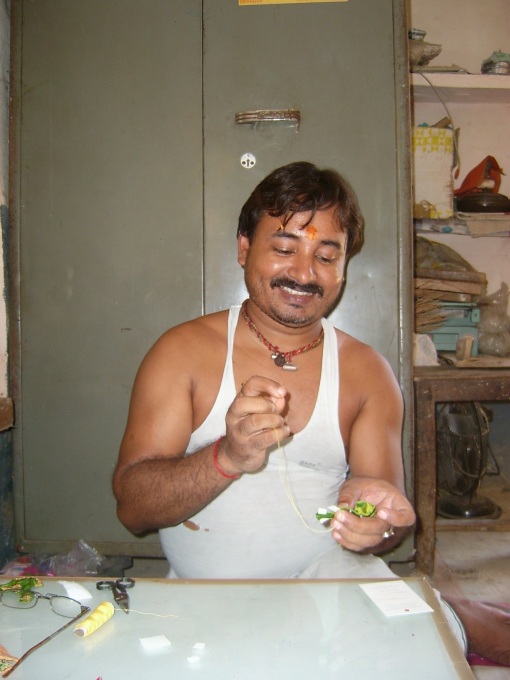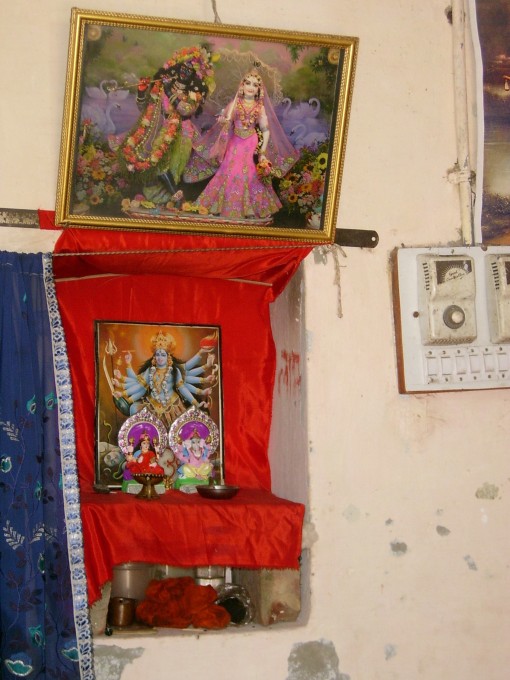Still in Vrindavan and plan to leave now on Saturday 25th. My back has seized up a bit from sleeping directly under a full-power fan…so ironically in this heat I’m treating it with Tiger balm, a fiery emollient to treat stiffened muscles.
In any case, now I walk with a little less Celtic bouncy pace and with the heat to also slow me down I am shocked to recognise that even I have gained some semblance of the grace and elegance with which everyone walks over here. That lovely languid gait and the whole rhythm of life here is so intimately linked to the weather.

Rice Lady
Next time I buy rice for an OCHS Wednesday lunch I’m going to try this on the Cowley road! Such graceful yet practical skill. The man below was an equally graceful porter who simply moved his banana business to the shade when the heat went up.

The Mobile Banana Company
But the art of walking is not the only skill that impresses. Everywhere I look there’s someone with a talent to marvel at back home, yet who just blend with the landscape of faces over here.
There are countless bead-makers who provide for a whole range of japa-malas or strings of prayer beads for different traditions. The favoured Vaishnava bead is made from the sacred Tulasi plant which seems to be the speciality of this craftsman.

Mala Maker
A couple of days ago I met a young man who gave me directions to Imlitala where Pishima lives. He looked like a million other young men here with nothing to distinguish him from every other rick shaw walla around, and yet when I saw him again he was painting a beautiful bas relief of Radha and Krishna beside a newly constucted temple at Imlitala.
There is really no way of telling who I’m dealing with over here. So many amazing people with little to advertise their craft, skill, asceticism or devotion. Mind you that’s the thinking behind the Hindu teaching of respect for all living beings. On a more theological level, it teaches that we have in fact no idea who we are dealing with, in terms of the real self/soul’s journey, the hidden story of a person’s life what to speak of the hidden journey of many lifetimes that karma and reincarnation dictate.
Respect is a consequence of recognising at least in theory, the spiritual nature of all life and also the safest way to avoid misjudging someone through ignorance of the bigger picture.

Radha and Krishna in bas relief
Speaking of Radha and Krishna, I met another man known to all as Tapan who has a small little workshop here where he designs and sews outfits for Temple deities throughout Vrindavan. He has developed such a reputation for his creative designs and impeccable work that he is in demand internationally with people coming to Vrindavan from far and wide to have a ‘Tapan’ piece of work.

Tapan - haute culture for deities
He has been sewing for 35 years and running his own workshop for 25 years. He hails from a Vaishnava family with his grandfather an artist in Orissa. It was his father who turned from painting to sewing and taught Tapan all he knows. Today the whole family can sew and he hopes to expand his workshop when he has trained his sons to his standard of expertise.

The Sewing Family - a family that sews together grows together - to coin a phrase
His son works with him in his workshop and as is usual everywhere here there is an altar at the centre of activities as he says himself “to remind him that this is’ seva’ or a devotional service to Krishna, but also to bless him with a profitable business. Not too heavenly minded to be of no earthly use and it seems his puja and prayers have been answered. In his house he has a a temple room in which he offers prayers every morning before the business day starts.

Radha Krishna, Kali, Ganesh and Laksmi

Family work shop





































